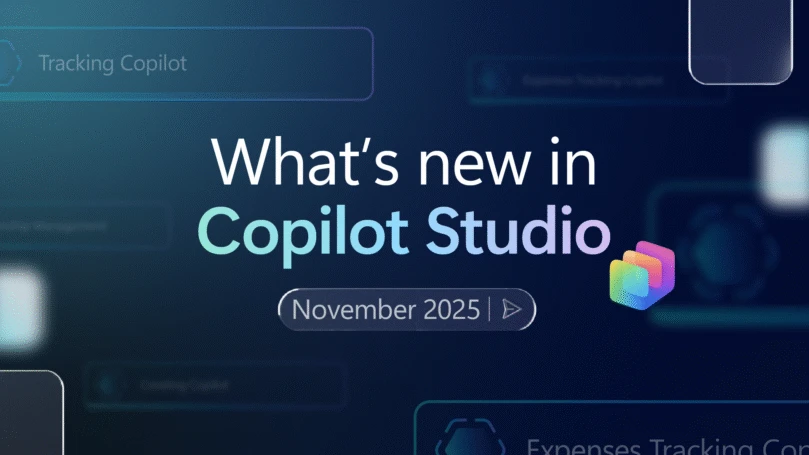Business runs on content—proposals, contracts, invoices, designs, plans, legal documents, images, training videos, and more. According to IDC, by 2025 there will be more than 130 billion terabytes of content.1 This content is often unstructured, locked up in siloed repositories, or worse, sitting as paper in a warehouse. The patchwork of disconnected systems and processes leaves gaps in classification and organization. This all makes it challenging to use content at scale effectively. And emerging digital work trends have changed the boundaries and frontiers of where we work—by escalating security and compliance needs as content is accessed from more places than ever. Today, organizations spend $46 billion per year storing and managing content2, and time spent looking for the right content can impact productivity by 11 to 14 percent.3
Storage alone is not the answer. What’s needed is a new category of technology solutions called Content AI. Content AI utilizes advancements in cloud and AI to transform how content is created, processed, and discovered—empowering people and automating workflows at scale. It builds on cloud content services platforms and intelligent document processing with AI-powered workflows that transform digital work.
Microsoft Syntex
We’re honored that customers trust Microsoft with their collaborative and mission-critical content. Every workday, on average, our customers add over 1.6 billion documents to Microsoft 365.
Today at Microsoft Ignite, we’re proud to launch Microsoft Syntex. Microsoft Syntex is Content AI integrated in the flow of work. It puts people at the center, with content seamlessly integrated into collaboration and workflows, turning content from a cost into an advantage. Syntex automatically reads, tags, and indexes high volumes of content and connects it where it’s needed—in search, in applications, and as reusable knowledge. It manages your content throughout its lifecycle with robust analytics, security, and automated retention.
Whether you’re focused on customer transactions, processing invoices, writing a contract that requires a signature, or struggling to understand the flood of unstructured content, Content AI with Syntex can help.
Let’s look at how Syntex helps you enhance, manage, and connect your content at scale.
Enhance
Syntex’s no-code AI enhances your content to help you understand and structure information, simplifying your business workflows. Whether you’re working with highly structured content like forms or text-heavy content like contracts, you can build models to understand your content the way you do. Syntex extends AI capabilities such as summarization and translations into the Microsoft 365 apps you already use, empowering you to engage them in the flow of work.
Document processing
Syntex helps you understand, tag, and secure information, integrating AI from Microsoft Azure, AI Builder, and other Microsoft sources. Syntex brings structure to your content, which is all part of our approach to intelligent document processing. Your content can be easily classified, tagged with extracted data, and secured with sensitivity and retention labels. These labels and taxonomy tags are integrated into Microsoft Viva Topics, seamlessly turning content into knowledge. Document processing is available now.

Translation
With business spanning many countries and cultures, Syntex enables you to translate content among dozens of languages.

Summarization
To help you focus on what’s important and needs action, Syntex uses AI to generate summaries of content to distill key points, on demand or using rules.

Content assembly
When you’re ready to create a new contract, invoice, letter, or other document, Syntex can help you automatically generate that document with templates and metadata using content assembly, which is available now.

Images, audio, and video processing
Images are one of the most common file types in Microsoft 365. You can process and tag images with nearly 10,000 automatically recognized objects “out of the box.” You will be able to automatically extract text from images in SharePoint and Exchange using optical character recognition (OCR) to optimize search and compliance.
Digital media is a major part of modern content, which is why we’re making transcription for audio and video available as part of Syntex. Extracting text from audio, especially meetings, is crucial to search and compliance, and we’re leveraging innovations from Microsoft Stream to automatically produce video transcripts for twenty-eight different languages and locales.
Connect
Syntex is designed to connect your content—helping you discover and reuse content with AI-powered search, eSignature, and integration into business workflows like contracts and invoice management.
Ignite 2022: Introducing Microsoft Syntex—Content AI for the Microsoft Cloud
eSignature
Enriching content is a vital factor to help you discover content and reuse it in business processes and applications. One of the fastest growing content transactions is eSignature. You can send electronic signature requests using Syntex, Adobe Acrobat Sign, DocuSign, or any of our other eSignature partner solutions and your content stays in Microsoft 365 while it’s being reviewed and signed.
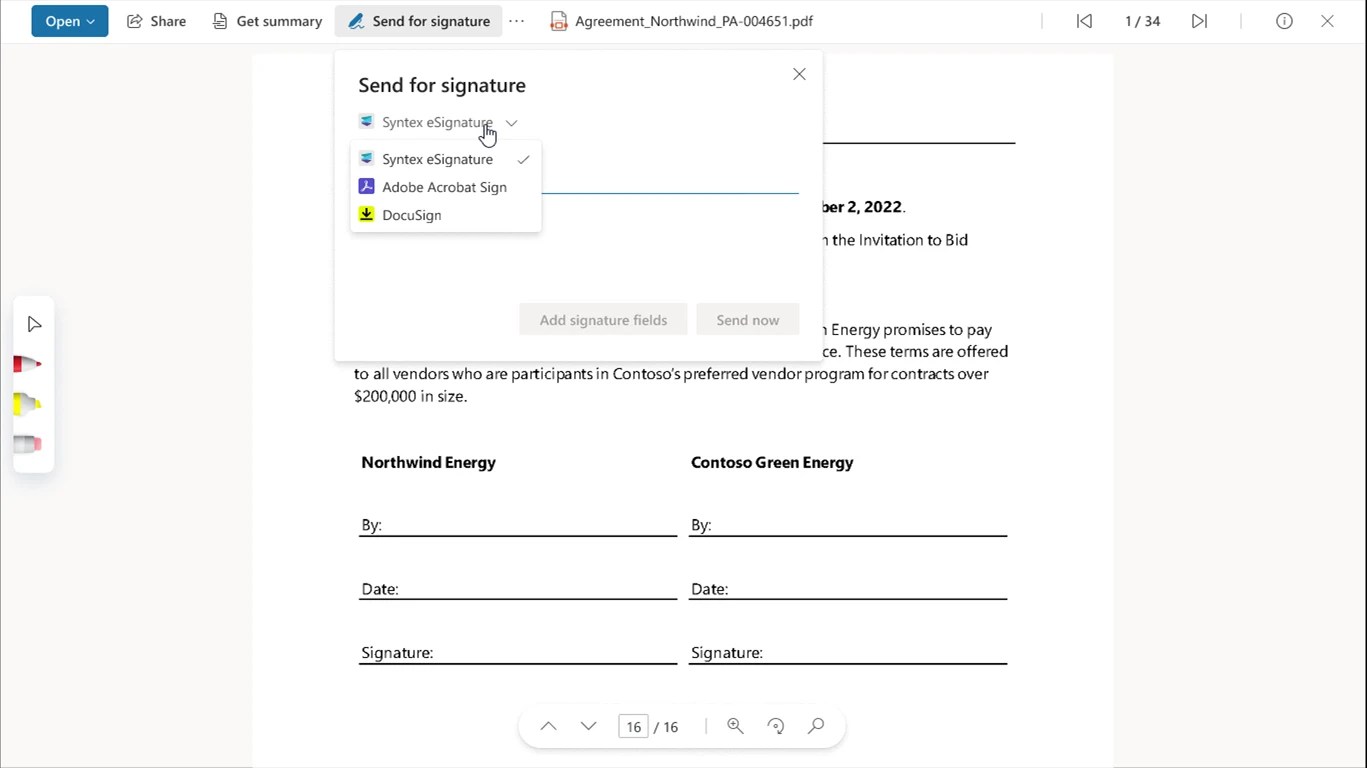
Search
Syntex also brings the power of Microsoft Search to Content AI. As a part of Syntex, Microsoft Search becomes even more insightful through innovative deep learning models that encompass semantic understanding, question-and-answering, and natural language processing to help you intuitively discover information.
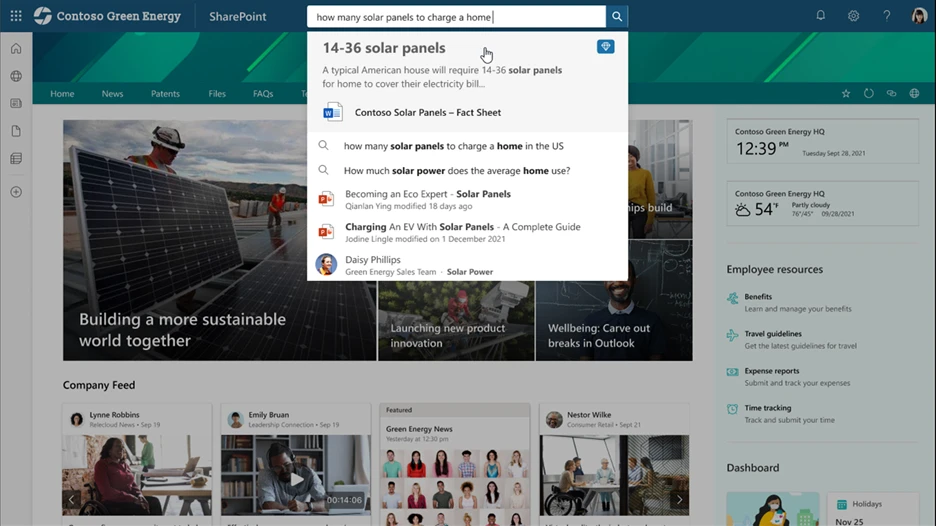
These new investments in Microsoft Search with Syntex will be available in 2023 and include:
- Natural language queries that let you ask specific questions like, “Show me sales presentations in California from last year for Contoso Electronics.”
- Semantic search lets you search by concept rather than keyword, resulting in better relevancy.
- Employees May Ask lets you expand your search and explore answers to related questions, leveraging Microsoft AI that automatically generates question-answer pairs.
Syntex builds on top of Microsoft Search to provide powerful ways to query, shape, and discover the content and data embedded in your files. You can use form-based content queries to get back to any specific document easily. Coming next year, Syntex will let you save, share, and manage queries for you and your teams.
Annotation
You can use annotations, like ink, notes, redactions, stamps, and comments, on any content—not just Office documents—without modifying the original files, so you can preserve original records for critical business processes.

Content rules processor
The Syntex content processor lets you build simple rules to trigger the next action, whether it’s a transaction, an alert, a workflow, or just filing your content in the right libraries and folders.
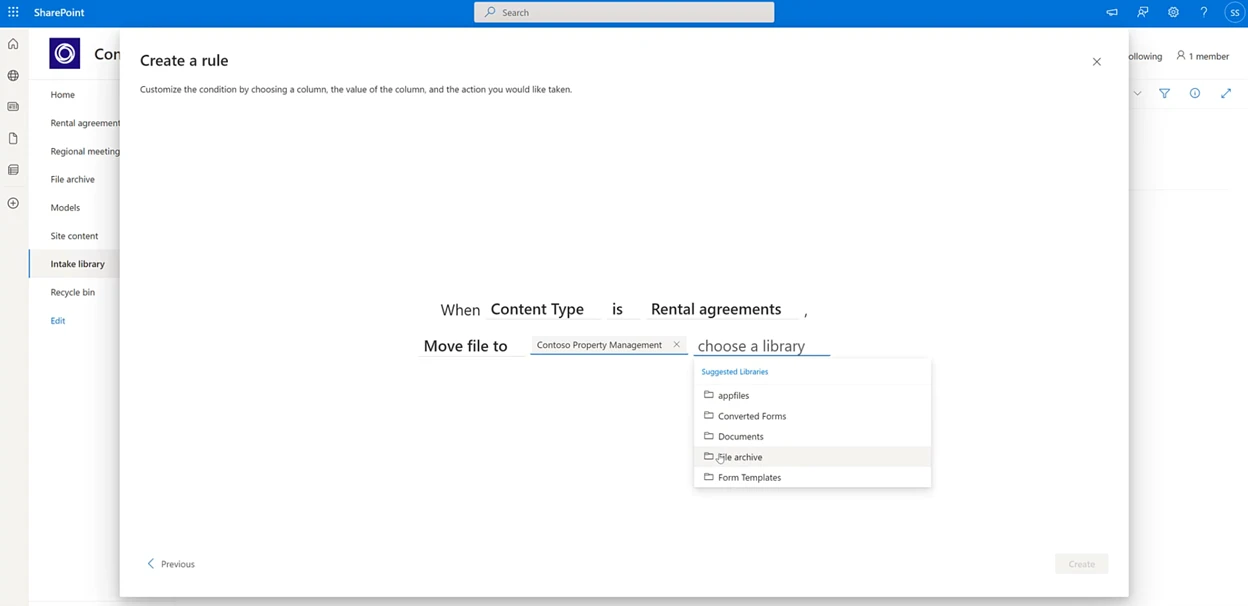
Accelerators and templates
Finally, Syntex also provides a growing range of solution accelerators for common patterns and scenarios that every organization faces. Today you can use our solution accelerator for contract management, and we’re announcing our new solution for accounts payable coming later this year.
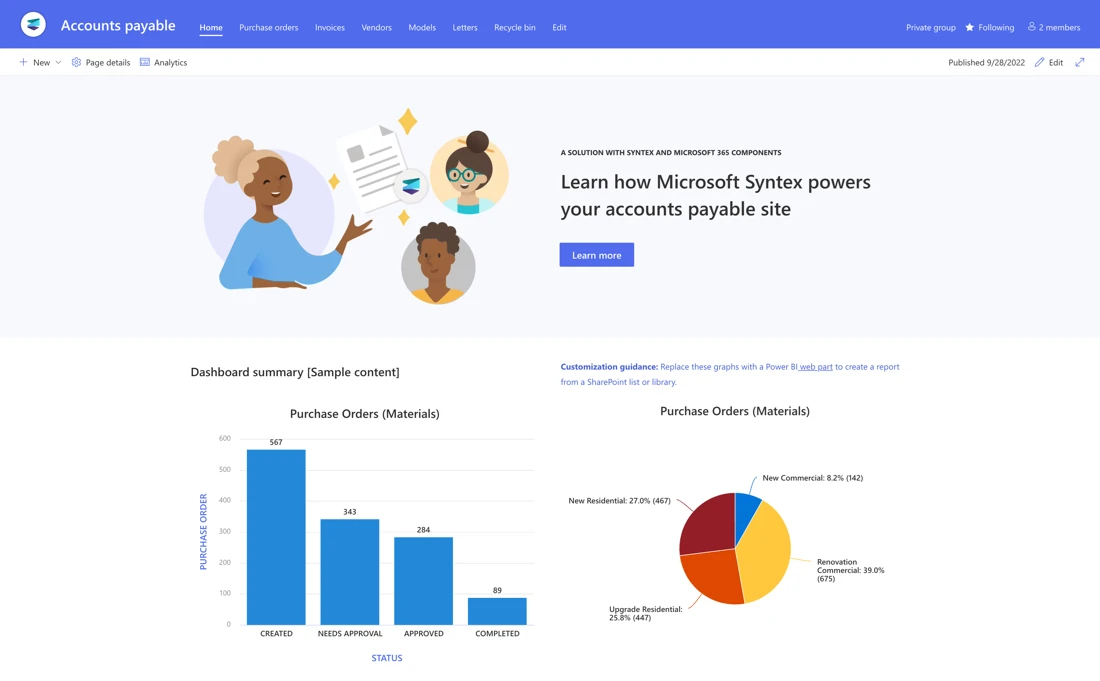
We’re also investing in new ways to turn your libraries, sites, and processes into reusable templates to deploy to Microsoft Teams and SharePoint in your environment or across multiple tenants.
Integrations
Syntex services offers new ways to create content-centric apps and processes. Many Syntex services, such as content assembly and structured document processing models, are tightly coupled to Microsoft Power Automate and Microsoft Power Platform. Syntex also lets you use AI Builder models for structured and freeform document processing alongside unstructured document models.
Most critical line of business applications consumes and generates lots of content. But too often, those content stores are siloed and disconnected from Microsoft 365. Most content begins in Microsoft 365—statements of work, for example—but once uploaded to your accounting system, they get disconnected from your cloud. Wouldn’t it be great to use the content platform you already have?
Next year, we’ll roll out new business app integration plugins, allowing you to use Microsoft 365 as the content engine for critical line of business systems. Today, these systems all work with and generate thousands of pieces of content, but often require a disconnected repository outside of Microsoft 365, or even storage within the line of business system’s expensive database storage, for storing the content. Syntex will allow you to use Microsoft 365 as the content platform for Dynamics 365 and many other critical line of business applications from third parties.
Manage
Microsoft 365 provides highly resilient and reliable storage, however bringing more and more content into the cloud requires new flexible ways of managing it. That’s why Syntex offers tools to manage, backup, and restore your content. It’s important to get maximum value from your content by keeping it in Microsoft 365, but we also understand the need to manage storage costs and comply with long-term archiving needs.
Backup and restore
Whether you need malware protection or preserved file copies from a particular point in time, Syntex backup can help. It preserves the state of your cloud—across Syntex, SharePoint, OneDrive, and Exchange—so that you can get back to information from the last quarter, the last month, or the last decade with ease, keeping your backup stored conveniently in the Microsoft Cloud. Your backup is highly available and tightly integrated with your content policies.
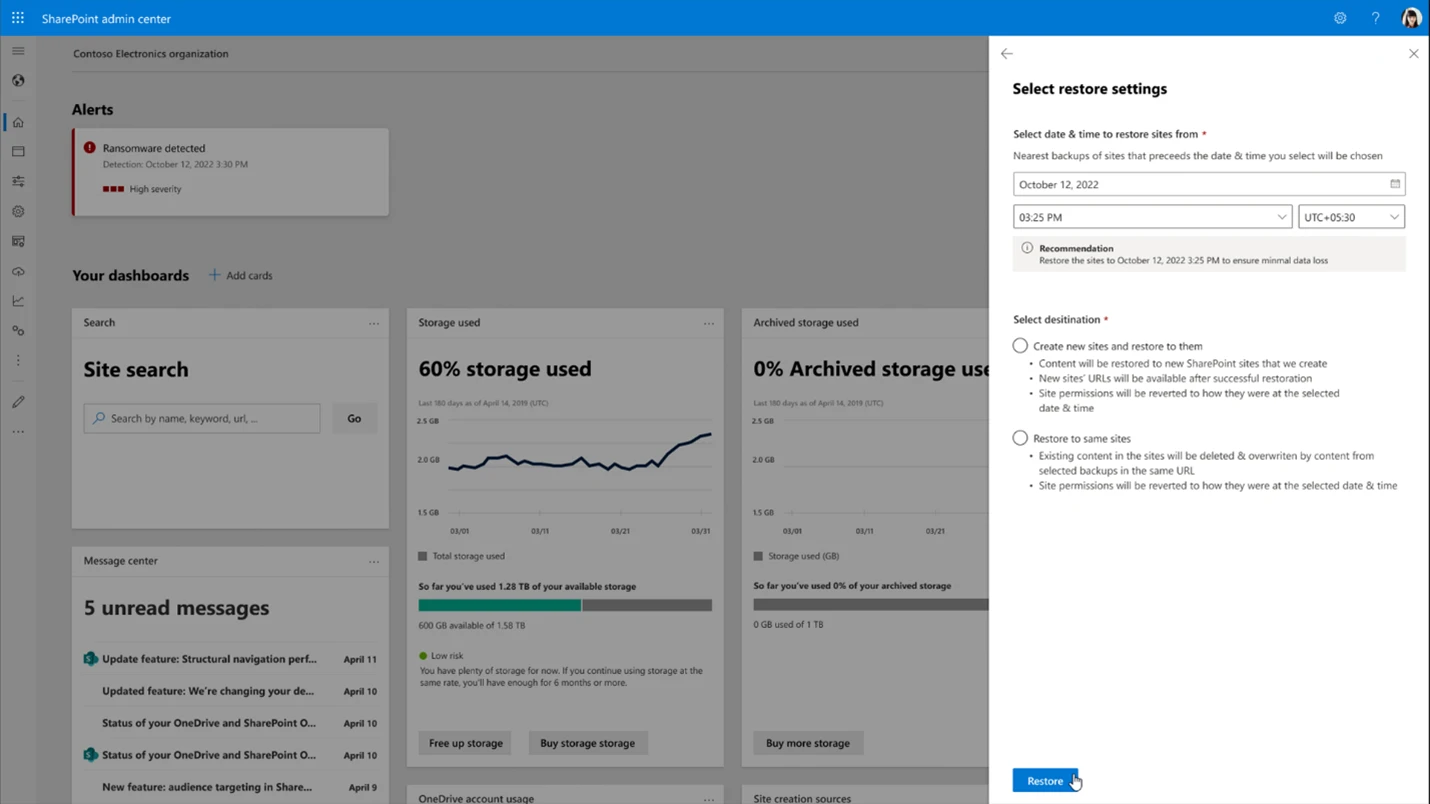
Tiered storage
More content requires cost flexibility. Next year, we’ll also introduce Syntex archiving, allowing you to establish simple rules to move less critical content from SharePoint and Microsoft Teams to lower cost storage—kept in the cloud with the security and search you need.
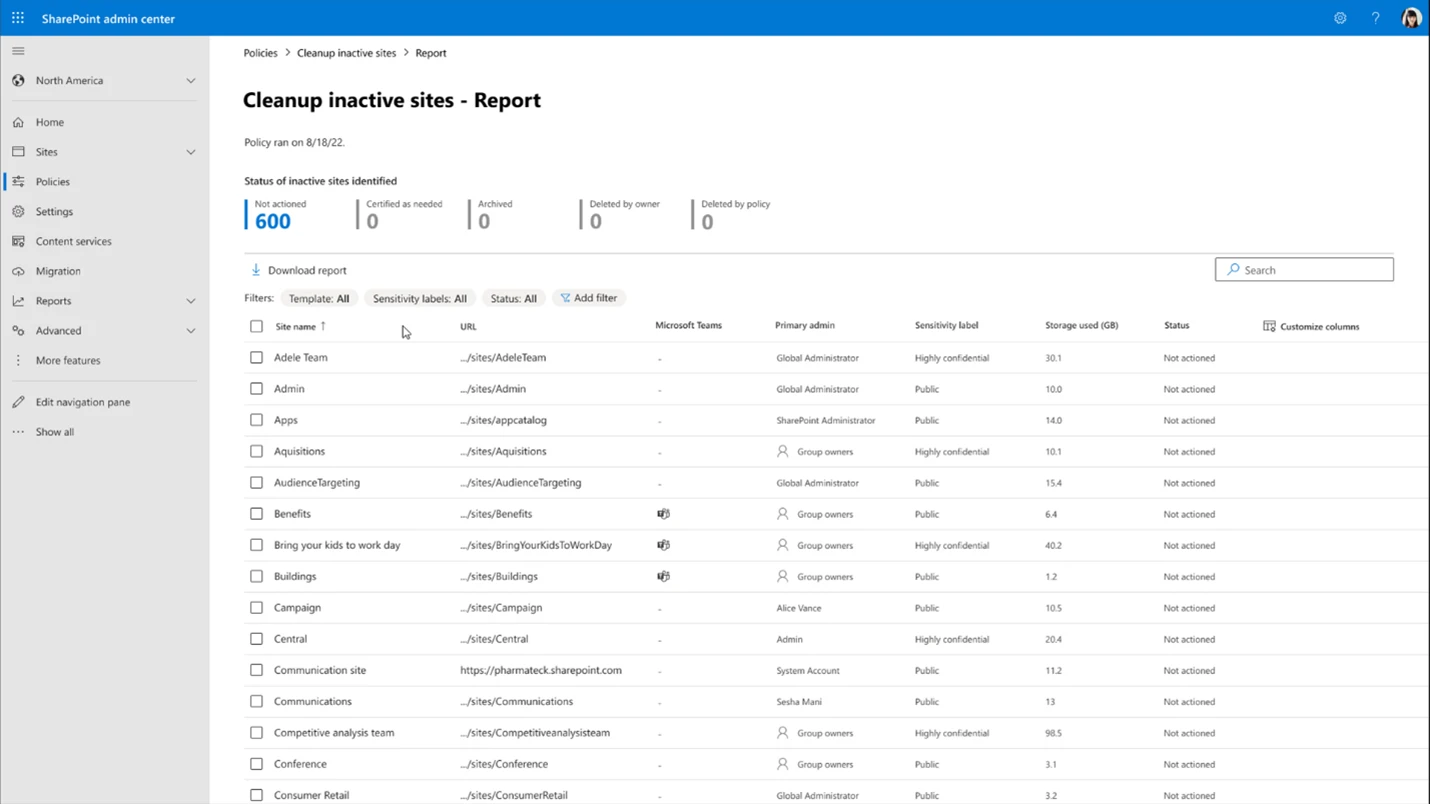
Security and content management
Of course, bringing content and process together in Syntex requires world-class management capabilities. That’s the role of the Syntex Protector, which:
Microsoft Syntex
- Helps ensure that only approved internal and external resources can access sensitive content with advanced document library security and restricted access control policy.
- Get insights about sites where information may be overshared, with AI powering the new data access governance report.
- Engage data owners in site access reviews to review and attest the existing site permission and access controls for their content, helping security reflect business needs.

The Syntex ecosystem
Microsoft partners have helped deliver content solutions based on SharePoint and OneDrive to customers, expanding to include capabilities from Microsoft Power Platform, Stream, Microsoft Purview, Microsoft Viva Topics, and now Microsoft Syntex. We’re honored to introduce our Microsoft Syntex Launch Partners:
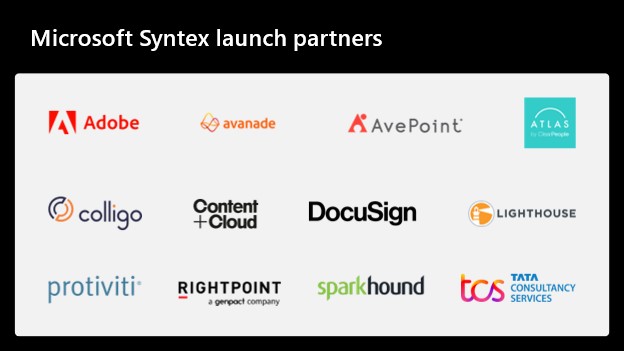
“Syntex has powered richer content intelligence experiences for our customers, creating better search and knowledge experiences and enabling deeper process integration into the digital workspace. The ease of use and power of machine learning and AI unlock value previously out of reach for many customers.“
—Jesse Murray, Senior Vice President, Employee Experience, Rightpoint.
We’re grateful for the partnerships with Adobe, Avanade, AvePoint, ClearPeople, Colligo, Content+Cloud, DocuSign, Lighthouse, Protiviti, Rightpoint, SparkHound, TCS, and many others.
These partners and many more work with Microsoft through the Microsoft Content AI Partner Program (CAPP). CAPP supports our partners delivering solutions that make the transformation of your content management approach practical and attainable. If you’re a partner, you can learn more about the program, apply to join, or subscribe to our newsletter.
Customers using Syntex
Over the past year, early adopter customers like Northumbrian Water Group, the London Stock Exchange Group, and Aurecon have relied on Syntex to deliver content AI and digital transformation to their operations, helping shape and improve the product. We’re pleased to share even more customer success with you as we now launch Microsoft Syntex.
TaylorMade

TaylorMade Golf Company, founded in 1979, is a global golf equipment provider. TaylorMade has a legacy of breaking from tradition to reach new thresholds of performance and leads the industry in product innovation. They bring precision to all aspects of their operations, creating revolutionary products year after year and attracting many of the greatest athletes in all of golf.
TaylorMade’s journey with Syntex began with their legal team and Lighthouse (a Preferred Microsoft CAPP partner). They needed a comprehensive document management system to organize and secure emails, attachments, and other documents for intellectual property and patent filings.
Beyond securing and processing legal documents, they’re also using Syntex to explore bringing content AI to processing orders, receipts, and other transactional documents for their accounts payable and finance teams. Read more about TaylorMade and Syntex in our new customer story.
What’s next
Files and documents play a critical role in modern apps. We’ll continue to use Syntex to provide developer-optimized storage for the next generation of content-centric apps. In 2023, we’ll introduce new APIs in the Microsoft Graph to help you integrate Content AI into the flow of your applications, creating new ways to harvest Microsoft’s content management investments directly in your apps. If you need to build queries that look at all your content in Microsoft 365—potentially billions of files—Syntex will allow you to bring large datasets into Azure Synapse Analytics for additional data analytics and modeling. We’ll have more to share on Syntex for developers in 2023.
We’re already working with the next wave of product innovators and partners—many of them listed above—to build the next generation of content apps with Syntex. If you’re interested in learning more, we’d love to hear from you—sign up for Syntex today.
Get started with Microsoft Syntex
Microsoft Syntex is available now, including document processing, annotation, content assembly, content query, accelerators, and more. More services are coming to public preview later this year and even more coming in 2023.
This week at Microsoft Ignite, you can learn more in Jeff Teper’s session, Introducing Microsoft Syntex—Content AI for the Microsoft Cloud (October 13, 2022 at 11:00 AM Pacific Time). Also, check out the Getting Started page on the Syntex Adoption Hub, which brings together all our Microsoft Ignite content, assessment tools, workshops, training, demos, research, adoption guides, and more.
Finally, you can learn more about Microsoft Syntex on today’s Intrazone podcast with Microsoft’s Ian Story and Chris McNulty, as well as Alan Pelz-Sharpe (Founder, Deep Analysis). And don’t miss the new Microsoft Mechanics show, Introducing Microsoft Syntex, with Microsoft’s Omar Shahine.


